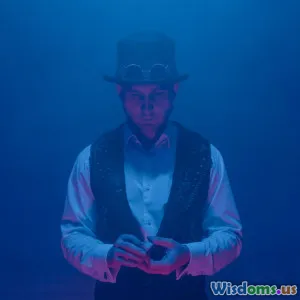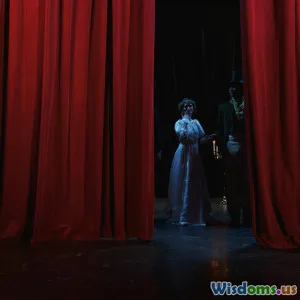
Secrets of Stage Magic Unveiled
7 min read Dive into the captivating world of stage magic and uncover the secrets behind enthralling illusions. (0 Reviews)
Secrets of Stage Magic Unveiled
Magic on stage has enthralled audiences for centuries, blending mystery, psychology, and craftsmanship into dazzling performances. While the astonishment is often attributed to supernatural powers, the true magic lies in skill, technique, and showmanship. Today, we will peel back the curtain to reveal the captivating secrets behind some of the most iconic stage illusions.
The Power of Misdirection: Where Attention Diverts
At its core, magic depends on misdirection—the art of focusing the audience’s attention away from the mechanics of the trick. Magician Ricky Jay famously said, “People love to be fooled, but they only enjoy being fooled when they don’t realize it.” This delicate balance depends heavily on controlling when and where the audience looks.
For example, in the classic coin vanish, the magician’s fluid hand movements and confident patter guide the spectator’s gaze. Meanwhile, sleight of hand discreetly removes or conceals the coin. Research in cognitive psychology highlights that humans have limited attentional capacity; magicians exploit this by overwhelming visual channels with dynamic gestures and eye contact. This tactic, combined with storytelling or humor, makes the illusion seamless and captivating.
Sleight of Hand: The Magician's Dexterity
Sleight of hand involves refined manual techniques enabling magicians to perform seemingly impossible manipulations. From card flourishes to vanishing acts, sleights are foundational to close-up magic.
Take the "Double Lift," a technique where the performer deceptively lifts two cards as one to switch or reveal the wrong card. This maneuver requires hours of practice to perfect smoothness and timing.
Magician David Copperfield, renowned for his grand illusions, openly credits years of dedicated sleight training as vital. The precision and muscle memory behind these subtle actions distract and mislead audiences into perceiving magic.
Classic Stage Illusions: Design and Engineering
Many stage illusions combine physical design with mechanical ingenuity to baffle spectators. Let's explore a few timeless examples:
The Lady Sawing Illusion
First gaining popularity in the early 20th century, the "Sawing a Woman in Half" trick requires precise craftsmanship. The apparatus is typically a box large enough to conceal an assistant curled strategically. The saw movement is choreographed carefully, and surprise elements—like moving hands or feet—sell the illusion.
In reports of the original performances, audiences marveled at how the magician flawlessly synchronized props plus human coordination, emphasizing showmanship more than mystery.
Levitation Acts
Levitation dazzles by defying gravity. Behind the scenes, magnetic supports, thin wires, or hidden platforms are commonly employed. Magicians like Harry Blackstone Jr. innovated by integrating lighting and mirror tricks to render supports invisible.
Advanced acts use earthy illusions such as "Balducci Levitation," which creates the appearance of floating a few inches off the ground, evaluated as a purely psychological illusion by cognitive scientists.
Psychological Principles Amplifying Magic
Magic doesn't solely rely on physical props but integrates psychological insights.
Confirmation Bias and Expectation
Audiences often approach magic shows expecting inexplicable feats. This predisposition helps magicians manipulate expectations, making outcomes feel more extraordinary.
Pattern Recognition and Closure
Humans are wired to seek patterns and complete incomplete information. Magicians disrupt this by leaving small gaps of uncertainty, leading audiences to fill in mental blanks—effectively ‘completing’ the illusion.
Showmanship: Engaging the Audience
No matter the illusions, the magician’s charisma and storytelling pull the entire performance together. Legendary magicians like Penn & Teller weave humor, suspense, and interactive elements so their medium remains engaging as well as mystifying.
Theatrical elements—lighting, music, costume design—amplify the mood and emotional impact. For example, David Blaine's street magic focuses on raw emotional reactions, contrasting traditional stage flair but equally captivating.
Modern Innovations: Technology and Magic
With advances in technology, magicians blend classic techniques with digital innovation.
Augmented reality (AR), holography, and robotics are now woven into illusions. An example is Marco Tempest’s augmented reality magic acts, which integrate virtual images and live interaction, expanding traditional magic’s scope while maintaining secrecy.
Ethics and Mystery: Why Secrets Matter
Maintaining secrecy preserves the magic's wonder and respects the craft. Revealing secrets can diminish artistry and audience experience.
Magician John Nevil Maskelyne argued, "Magic's power is in the unknown. Once unraveled, the spell breaks." Responsible magicians carefully balance revealing some insights while protecting the core mystery.
Conclusion: The Everlasting Allure of Stage Magic
Stage magic is a masterful blend of artistry, psychology, and skill, meticulously crafted to surprise and delight. Its secrets lie not just in tricks but in understanding human nature and crafting enthralling narratives.
By unveiling just a portion of these secrets—from misdirection and sleight of hand to engineering and psychology—we appreciate how much dedication and creativity underpins every illusion. Next time you witness a magic show, remember: it’s less about supernatural powers and more the profound expertise behind the scenes.
The magic, after all, lives in our imagination and the shared experience.
References:
- Fitzkee, Dariel. Showing the Trick: Magic for the Artist. Dover, 2002.
- Kuhn, Gustav, et al. "Misdirection—Past, Present, and Future." Frontiers in Psychology, 2014.
- Rensink, Ronald A., & Kuhn, Gustav. "A Framework for Using Magic to Study the Mind." Frontiers in Psychology, 2015.
- Jay, Ricky. Learned Pigs and Fireproof Women. Gallimard, 1986.
- Maskelyne, John Nevil. Sharps and Flats: The Romance of Magic. 1947.
Rate the Post
User Reviews
Popular Posts



















